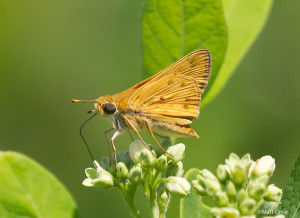Fresh off a great day of butterflying during Saturday on the Loudoun county, VA count Barry and I headed to Kent county, MD in search of more coastal species and the possibility of southern irruptives. Although the NWR, which is on an island, is only 6 or 7 air miles from the Bay Bridge it takes a good hour to get from the bridge to the island unless you have a boat. From various vantange points you can see the Bay Bridge, Kent Narrows bridge, Francis Scott Key bridge and the city of Baltimore across the bay. Seeing all of that water makes it hard to imagine that the 180 mile long Chesapeake Bay’s average depth is only 22 feet! We spent four hours around the immediate area of the butterfly garden. The predominant nectoring sources now are some false Sunflowers, Ironweed and Joe-Pye Weed. Out of the thirty species seen half of them were skippers (Open-winged and Grass). Notables were Common Buckeye, Fiery Skipper and both Broken-Dashes.
7-11 Eastern Neck NWR, MD 76 Silver-spotted Skipper 8 Horace's Duskywing 1 Common-checkered Skipper 1 Swarthy Skipper 1 Least Skipper 5 Fiery Skipper 1 Peck's Skipper 1 Northern Broken-Dash 2 Southern Broken-Dash 38 Little Glassywing 2 Sachem 1 Delaware Skipper 17 Zabulon Skipper 6 Broad-winged Skipper 2 Dun Skipper 59 Zebra Swallowtail 17 Eastern Tiger Swallowtail 6 Spicebush Swallowtail 2 Cabbage White 3 Orange Sulphur 5 Gray Hairstreak 7 Eastern-tailed Blue 2 American Snout 2 Variegated Fritillary 25 Pearl Crescent 4 Red Admiral 1 Common Buckeye 1 Viceroy 9 Monarch 6 Red-spotted Purple
Click on any image below to enlarge
 |
 |
 |
 |

Matt, these are great shots of the two Broken Dashes. Note how the fore- and hind-wing edges are the same color on Northern and two-tone on the Southern. This is a key diagnostic field mark, and your pictures show it quite well. Tom Stock
Tom,
Thanks a bunch! Yes… definte differences in hind-wing fringes.